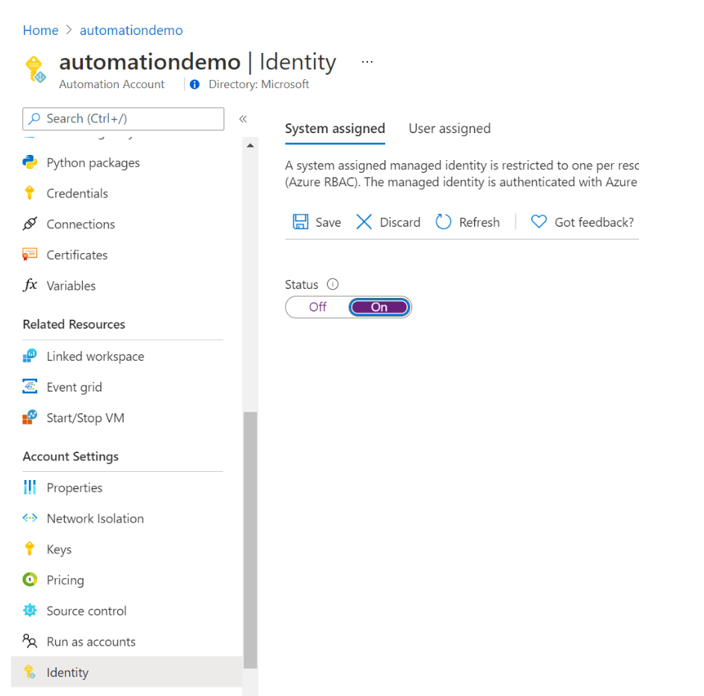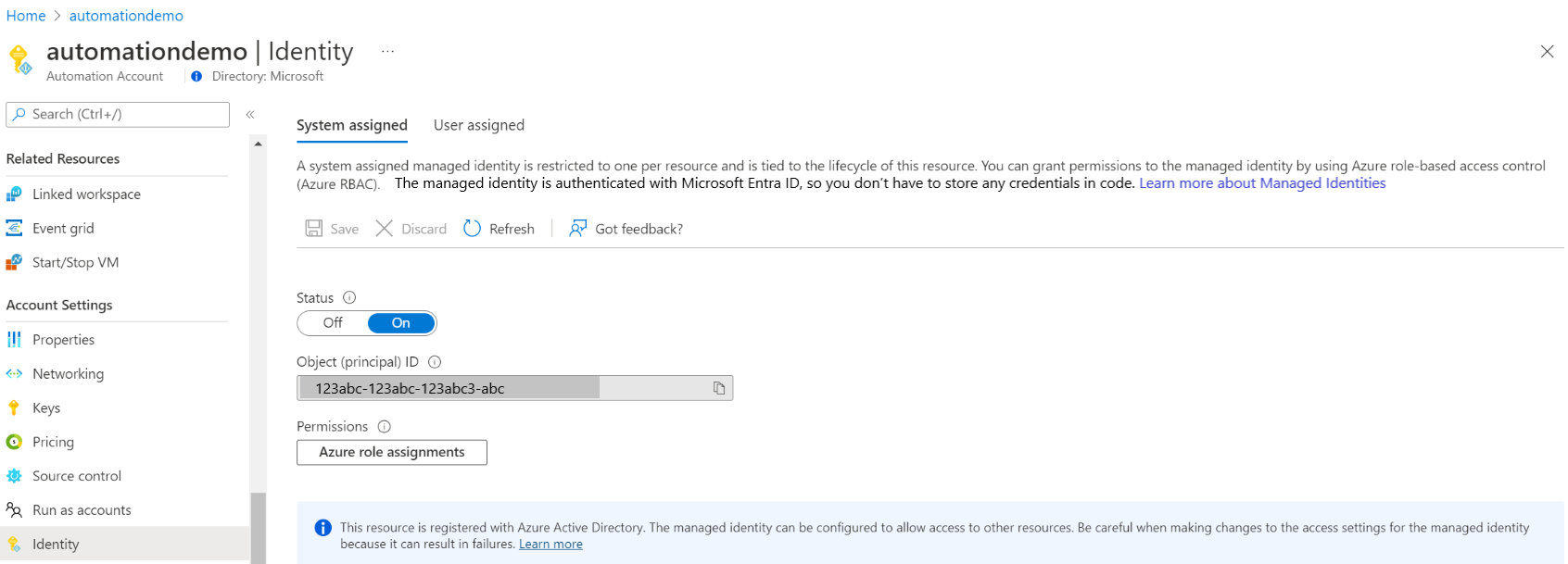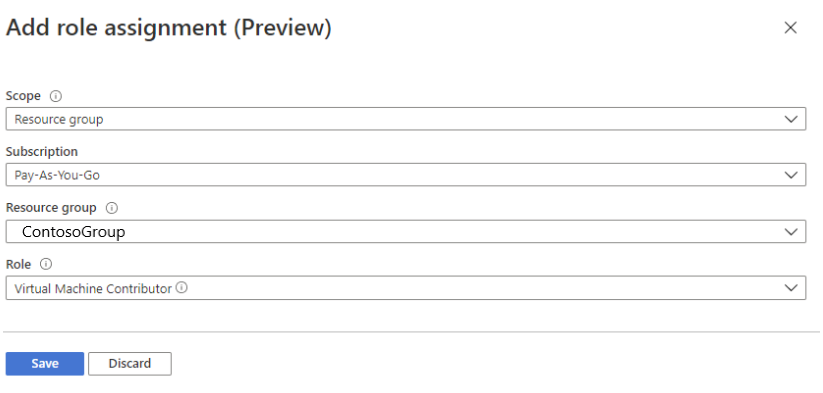Using a system-assigned managed identity for an Azure Automation account
This article shows you how to enable a system-assigned managed identity for an Azure Automation account and how to use it to access other resources. For more information on how managed identities work with Azure Automation, see Managed identities.
If you don't have an Azure subscription, create a free account before you begin.
Prerequisites
An Azure Automation account. For instructions, see Create an Azure Automation account.
The latest version of Az PowerShell modules Az.Accounts, Az.Resources, Az.Automation, Az.KeyVault.
An Azure resource that you want to access from your Automation runbook. This resource needs to have a role defined for the managed identity, which helps the Automation runbook authenticate access to the resource. To add roles, you need to be an owner for the resource in the corresponding Microsoft Entra tenant.
There is no minimum version requirement for extension-based Hybrid Runbook Worker, and all the versions would work. The minimum required versions for the agent-based Hybrid Worker are:
- Windows Hybrid Runbook Worker: version 7.3.1125.0
- Linux Hybrid Runbook Worker: version 1.7.4.0
To check the versions:
- Windows Hybrid Runbook Worker: Go to the installation path -
C:\ProgramFiles\Microsoft Monitoring Agent\Agent\AzureAutomation\.and the folder Azure Automation contains a sub-folder with the version number as the name of sub-folder. - Linux Hybrid Runbook Worker: Go to the path -
vi/opt/microsoft/omsconfig/modules/nxOMSAutomationWorker/VERSION.and the file VERSION has the version number of the Hybrid Worker.
To assign an Azure role you must have
Microsoft.Authorization/roleAssignments/writepermission such as User Access Administrator or Owner.
Enable a system-assigned managed identity for an Azure Automation account
Once enabled, the following properties will be assigned to the system-assigned managed identity.
| Property (JSON) | Value | Description |
|---|---|---|
| principalid | <principal-ID> | The Globally Unique Identifier (GUID) of the service principal object for the system-assigned managed identity that represents your Automation account in the Microsoft Entra tenant. This GUID sometimes appears as an "object ID" or objectID. |
| tenantid | <Azure-AD-tenant-ID> | The Globally Unique Identifier (GUID) that represents the Microsoft Entra tenant where the Automation account is now a member. Inside the Microsoft Entra tenant, the service principal has the same name as the Automation account. |
You can enable a system-assigned managed identity for an Azure Automation account using the Azure portal, PowerShell, the Azure REST API, or ARM template. For the examples involving PowerShell, first sign in to Azure interactively using the Connect-AzAccount cmdlet and follow the instructions.
# Sign in to your Azure subscription
$sub = Get-AzSubscription -ErrorAction SilentlyContinue
if(-not($sub))
{
Connect-AzAccount
}
# If you have multiple subscriptions, set the one to use
# Select-AzSubscription -SubscriptionId "<SUBSCRIPTIONID>"
Then initialize a set of variables that will be used throughout the examples. Revise the values below and then execute.
$subscriptionID = "subscriptionID"
$resourceGroup = "resourceGroupName"
$automationAccount = "automationAccountName"
Important
The new Automation account-level identity overrides any previous VM-level system-assigned identities which are described in Use runbook authentication with managed identities. If you're running hybrid jobs on Azure VMs that use a VM's system-assigned identity to access runbook resources, then the Automation account identity will be used for the hybrid jobs.
If you wish to continue using the VM's managed identity, you shouldn't enable the Automation account-level identity. If you've already enabled it, you can disable the Automation account system-assigned managed identity. See Disable your Azure Automation account managed identity.
Enable using the Azure portal
Perform the following steps:
Sign in to the Azure portal.
In the Azure portal, navigate to your Automation account.
Under Account Settings, select Identity.
Set the System assigned option to On and press Save. When you're prompted to confirm, select Yes.

Your Automation account can now use the system-assigned identity, which is registered with Microsoft Entra ID and is represented by an object ID.

Enable using PowerShell
Use PowerShell cmdlet Set-AzAutomationAccount to enable the system-assigned managed identity.
$output = Set-AzAutomationAccount `
-ResourceGroupName $resourceGroup `
-Name $automationAccount `
-AssignSystemIdentity
$output
The output should look similar to the following:

For additional output, modify the example to specify: $output.identity | ConvertTo-Json.
Enable using a REST API
Syntax and example steps are provided below.
Syntax
The body syntax below enables a system-assigned managed identity to an existing Automation account using the HTTP PATCH method. However, this syntax will remove any existing user-assigned managed identities associated with the Automation account.
{
"identity": {
"type": "SystemAssigned"
}
}
If there are multiple user-assigned identities defined, to retain them and only remove the system-assigned identity, you need to specify each user-assigned identity using comma-delimited list. The example below uses the HTTP PATCH method.
{
"identity" : {
"type": "SystemAssigned, UserAssigned",
"userAssignedIdentities": {
"/subscriptions/aaaa0a0a-bb1b-cc2c-dd3d-eeeeee4e4e4e/resourceGroups/resourceGroupName/providers/Microsoft.ManagedIdentity/userAssignedIdentities/cmkID": {},
"/subscriptions/aaaa0a0a-bb1b-cc2c-dd3d-eeeeee4e4e4e/resourceGroups/resourceGroupName/providers/Microsoft.ManagedIdentity/userAssignedIdentities/cmkID2": {}
}
}
}
The syntax of the API is as follows:
PATCH https://management.azure.com/subscriptions/aaaa0a0a-bb1b-cc2c-dd3d-eeeeee4e4e4e/resourceGroups/resource-group-name/providers/Microsoft.Automation/automationAccounts/automation-account-name?api-version=2020-01-13-preview
Example
Perform the following steps.
Copy and paste the body syntax into a file named
body_sa.json. Save the file on your local machine or in an Azure storage account.Update the variable value below and then execute.
$file = "path\body_sa.json"This example uses the PowerShell cmdlet Invoke-RestMethod to send the PATCH request to your Automation account.
# build URI $URI = "https://management.azure.com/subscriptions/$subscriptionID/resourceGroups/$resourceGroup/providers/Microsoft.Automation/automationAccounts/$automationAccount`?api-version=2020-01-13-preview" # build body $body = Get-Content $file # obtain access token $azContext = Get-AzContext $azProfile = [Microsoft.Azure.Commands.Common.Authentication.Abstractions.AzureRmProfileProvider]::Instance.Profile $profileClient = New-Object -TypeName Microsoft.Azure.Commands.ResourceManager.Common.RMProfileClient -ArgumentList ($azProfile) $token = $profileClient.AcquireAccessToken($azContext.Subscription.TenantId) $authHeader = @{ 'Content-Type'='application/json' 'Authorization'='Bearer ' + $token.AccessToken } # Invoke the REST API $response = Invoke-RestMethod -Uri $URI -Method PATCH -Headers $authHeader -Body $body # Review output $response.identity | ConvertTo-JsonThe output should look similar to the following:
{ "PrincipalId": "aaaaaaaa-aaaa-aaaa-aaaa-aaaaaaaaaaaa", "TenantId": "bbbbbbbb-bbbb-bbbb-bbbb-bbbbbbbbbbbb", "Type": 0, "UserAssignedIdentities": null }
Enable using an ARM template
Syntax and example steps are provided below.
Template syntax
The sample template syntax below enables a system-assigned managed identity to the existing Automation account. However, this syntax will remove any existing user-assigned managed identities associated with the Automation account.
{
"$schema": "https://schema.management.azure.com/schemas/2019-04-01/deploymentTemplate.json#",
"contentVersion": "1.0.0.0",
"resources": [
{
"type": "Microsoft.Automation/automationAccounts",
"apiVersion": "2020-01-13-preview",
"name": "yourAutomationAccount",
"location": "[resourceGroup().location]",
"identity": {
"type": "SystemAssigned"
},
"properties": {
"sku": {
"name": "Basic"
}
}
}
]
}
Example
Perform the following steps.
Revise the syntax of the template above to use your Automation account and save it to a file named
template_sa.json.Update the variable value below and then execute.
$templateFile = "path\template_sa.json"Use PowerShell cmdlet New-AzResourceGroupDeployment to deploy the template.
New-AzResourceGroupDeployment ` -Name "SystemAssignedDeployment" ` -ResourceGroupName $resourceGroup ` -TemplateFile $templateFileThe command won't produce an output; however, you can use the code below to verify:
(Get-AzAutomationAccount ` -ResourceGroupName $resourceGroup ` -Name $automationAccount).Identity | ConvertTo-JsonThe output will look similar to the output shown for the REST API example, above.
Assign role to a system-assigned managed identity
An Automation account can use its system-assigned managed identity to get tokens to access other resources protected by Microsoft Entra ID, such as Azure Key Vault. These tokens don't represent any specific user of the application. Instead, they represent the application that's accessing the resource. In this case, for example, the token represents an Automation account.
Before you can use your system-assigned managed identity to perform any actions within Azure, set up access for that identity on the Azure resource where you plan to use the identity. To complete this task, assign the appropriate role to that identity on the target Azure resource.
Follow the principal of least privilege and carefully assign permissions only required to execute your runbook. For example, if the Automation account is only required to start or stop an Azure VM, then the permissions assigned to the Run As account or managed identity needs to be only for starting or stopping the VM. Similarly, if a runbook is reading from blob storage, then assign read-only permissions.
The following example uses Azure PowerShell to show how to assign the Contributor role in the subscription to the target Azure resource. The Contributor role is used as an example, and may or may not be required in your case.
New-AzRoleAssignment `
-ObjectId <automation-Identity-object-id> `
-Scope "/subscriptions/<subscription-id>" `
-RoleDefinitionName "Contributor"
Verify role assignment to a system-managed identity
To verify a role to a system-assigned managed identity of the Automation account, follow these steps:
Sign in to the Azure portal.
Go to your Automation account.
Under Account Settings, select Identity.
Under Permissions, click Azure role assignments.
If the roles are already assigned to the selected system-assigned managed identity, you can see a list of role assignments. This list includes all the role-assignments you have permission to read.
To change the subscription, click the Subscription drop-down list and select the appropriate subscription.
Click Add role assignment (Preview)
In the drop-down list, select the set of resources that the role assignment applies - Subscription, Resource group, Role, and Scope.
If you don't have the role assignment, you can view the write permissions for the selected scope as an inline message.In the Role drop-down list, select a role as Virtual Machine Contributor.
Click Save.
After a few minutes, the managed identity is assigned the role at the selected scope.
Authenticate access with system-assigned managed identity
After you enable the managed identity for your Automation account and give an identity access to the target resource, you can specify that identity in runbooks against resources that support managed identity. For identity support, use the Az cmdlet Connect-AzAccount cmdlet. See Connect-AzAccount in the PowerShell reference.
# Ensures you do not inherit an AzContext in your runbook
Disable-AzContextAutosave -Scope Process
# Connect to Azure with system-assigned managed identity
$AzureContext = (Connect-AzAccount -Identity).context
# Set and store context
$AzureContext = Set-AzContext -SubscriptionName $AzureContext.Subscription -DefaultProfile $AzureContext
Note
If your organization is still using the deprecated AzureRM cmdlets, you can use Connect-AzureRMAccount -Identity.
Generate an access token without using Azure cmdlets
For HTTP Endpoints make sure of the following.
- The metadata header must be present and should be set to "true".
- A resource must be passed along with the request, as a query parameter for a GET request and as form data for a POST request.
- Set the value of the environment variable IDENTITY_HEADER to X-IDENTITY-HEADER.
- Content Type for the Post request must be 'application/x-www-form-urlencoded'.
Get Access token for system-assigned managed identity using HTTP Get
$resource= "?resource=https://management.azure.com/"
$url = $env:IDENTITY_ENDPOINT + $resource
$Headers = New-Object "System.Collections.Generic.Dictionary[[String],[String]]"
$Headers.Add("X-IDENTITY-HEADER", $env:IDENTITY_HEADER)
$Headers.Add("Metadata", "True")
$accessToken = Invoke-RestMethod -Uri $url -Method 'GET' -Headers $Headers
Write-Output $accessToken.access_token
Get Access token for system-assigned identity using HTTP Post
$url = $env:IDENTITY_ENDPOINT
$headers = New-Object "System.Collections.Generic.Dictionary[[String],[String]]"
$headers.Add("X-IDENTITY-HEADER", $env:IDENTITY_HEADER)
$headers.Add("Metadata", "True")
$body = @{resource='https://management.azure.com/' }
$accessToken = Invoke-RestMethod $url -Method 'POST' -Headers $headers -ContentType 'application/x-www-form-urlencoded' -Body $body
Write-Output $accessToken.access_token
Using system-assigned managed identity to access Azure Key Vault in Azure PowerShell
For more information, see Get-AzKeyVaultSecret.
Write-Output "Connecting to azure via Connect-AzAccount -Identity"
Connect-AzAccount -Identity
Write-Output "Successfully connected with Automation account's Managed Identity"
Write-Output "Trying to fetch value from key vault using MI. Make sure you have given correct access to Managed Identity"
$secret = Get-AzKeyVaultSecret -VaultName '<KVname>' -Name '<KeyName>'
$ssPtr = [System.Runtime.InteropServices.Marshal]::SecureStringToBSTR($secret.SecretValue)
try {
$secretValueText = [System.Runtime.InteropServices.Marshal]::PtrToStringBSTR($ssPtr)
Write-Output $secretValueText
} finally {
[System.Runtime.InteropServices.Marshal]::ZeroFreeBSTR($ssPtr)
}
Using system-assigned managed identity in Python Runbook
#!/usr/bin/env python3
import os
import requests
# printing environment variables
endPoint = os.getenv('IDENTITY_ENDPOINT')+"?resource=https://management.azure.com/"
identityHeader = os.getenv('IDENTITY_HEADER')
payload={}
headers = {
'X-IDENTITY-HEADER': identityHeader,
'Metadata': 'True'
}
response = requests.request("GET", endPoint, headers=headers, data=payload)
print(response.text)
Using system-assigned managed identity to Access SQL Database
For details on provisioning access to an Azure SQL database, see Provision Microsoft Entra admin (SQL Database).
$queryParameter = "?resource=https://database.windows.net/"
$url = $env:IDENTITY_ENDPOINT + $queryParameter
$Headers = New-Object "System.Collections.Generic.Dictionary[[String],[String]]"
$Headers.Add("X-IDENTITY-HEADER", $env:IDENTITY_HEADER)
$Headers.Add("Metadata", "True")
$content =[System.Text.Encoding]::Default.GetString((Invoke-WebRequest -UseBasicParsing -Uri $url -Method 'GET' -Headers $Headers).RawContentStream.ToArray()) | ConvertFrom-Json
$Token = $content.access_token
echo "The managed identities for Azure resources access token is $Token"
$SQLServerName = "<ServerName>" # Azure SQL logical server name
$DatabaseName = "<DBname>" # Azure SQL database name
Write-Host "Create SQL connection string"
$conn = New-Object System.Data.SqlClient.SQLConnection
$conn.ConnectionString = "Data Source=$SQLServerName.database.windows.net;Initial Catalog=$DatabaseName;Connect Timeout=30"
$conn.AccessToken = $Token
Write-host "Connect to database and execute SQL script"
$conn.Open()
$ddlstmt = "CREATE TABLE Person( PersonId INT IDENTITY PRIMARY KEY, FirstName NVARCHAR(128) NOT NULL)"
Write-host " "
Write-host "SQL DDL command"
$ddlstmt
$command = New-Object -TypeName System.Data.SqlClient.SqlCommand($ddlstmt, $conn)
Write-host "results"
$command.ExecuteNonQuery()
$conn.Close()
Migrate from existing Run As accounts to managed identity
Azure Automation provided authentication for managing Azure Resource Manager resources or resources deployed on the classic deployment model with the Run As account. To switch from a Run As account to a managed identity for your runbook authentication, follow the steps below.
Enable a system-assigned, user-assigned, or both types of managed identities.
Grant the managed identity the same privileges to the Azure resources matching what the Run As account was assigned.
Update your runbooks to authenticate using the managed identity.
Modify Runbooks to use the managed identity. For identity support, use the Az cmdlet
Connect-AzAccountcmdlet. See Connect-AzAccount in the PowerShell reference.- If you are using AzureRM modules, Update
AzureRM.Profileto latest version and replace usingAdd-AzureRMAccountcmdlet withConnect-AzureRMAccount –Identity. - If you are using Az modules, update to the latest version following the steps in the Update Azure PowerShell modules article.
- If you are using AzureRM modules, Update
Next steps
If your runbooks aren't completing successfully, review Troubleshoot Azure Automation managed identity issues.
If you need to disable a managed identity, see Disable your Azure Automation account managed identity.
For an overview of Azure Automation account security, see Automation account authentication overview.


